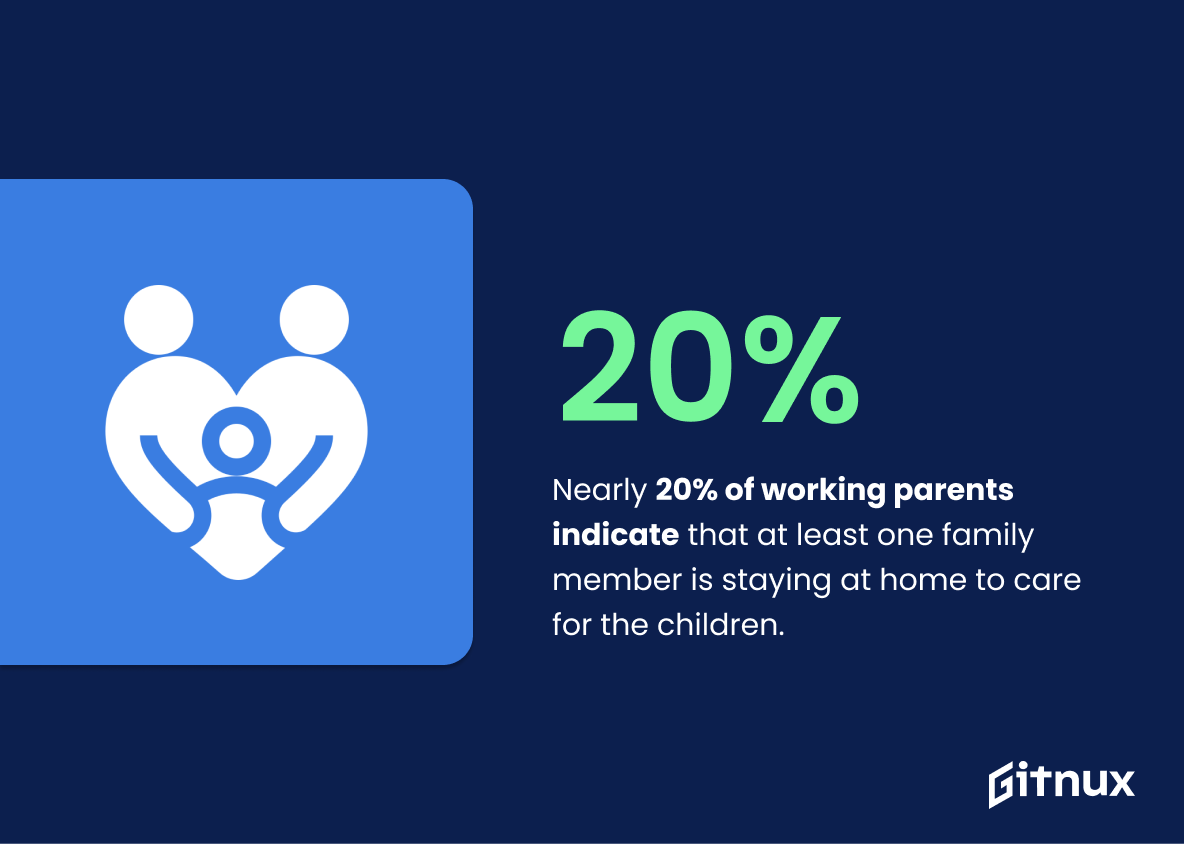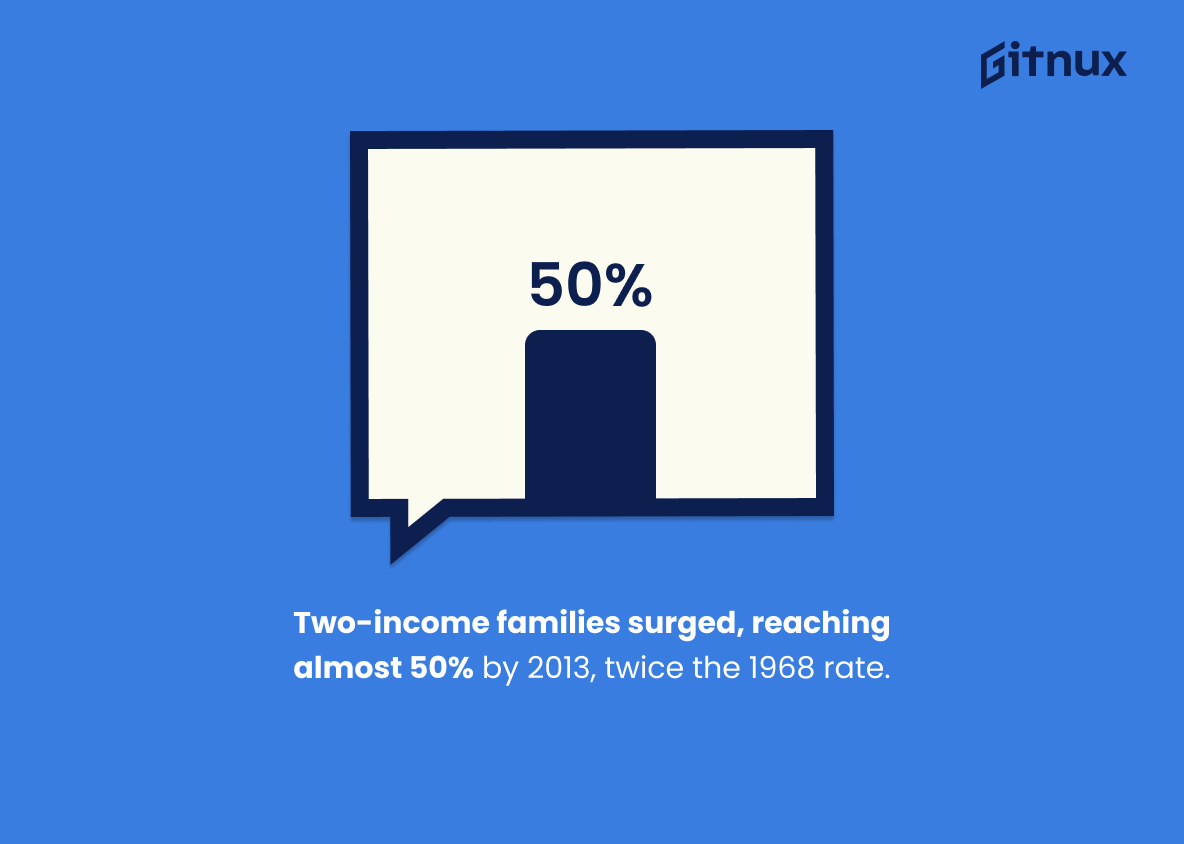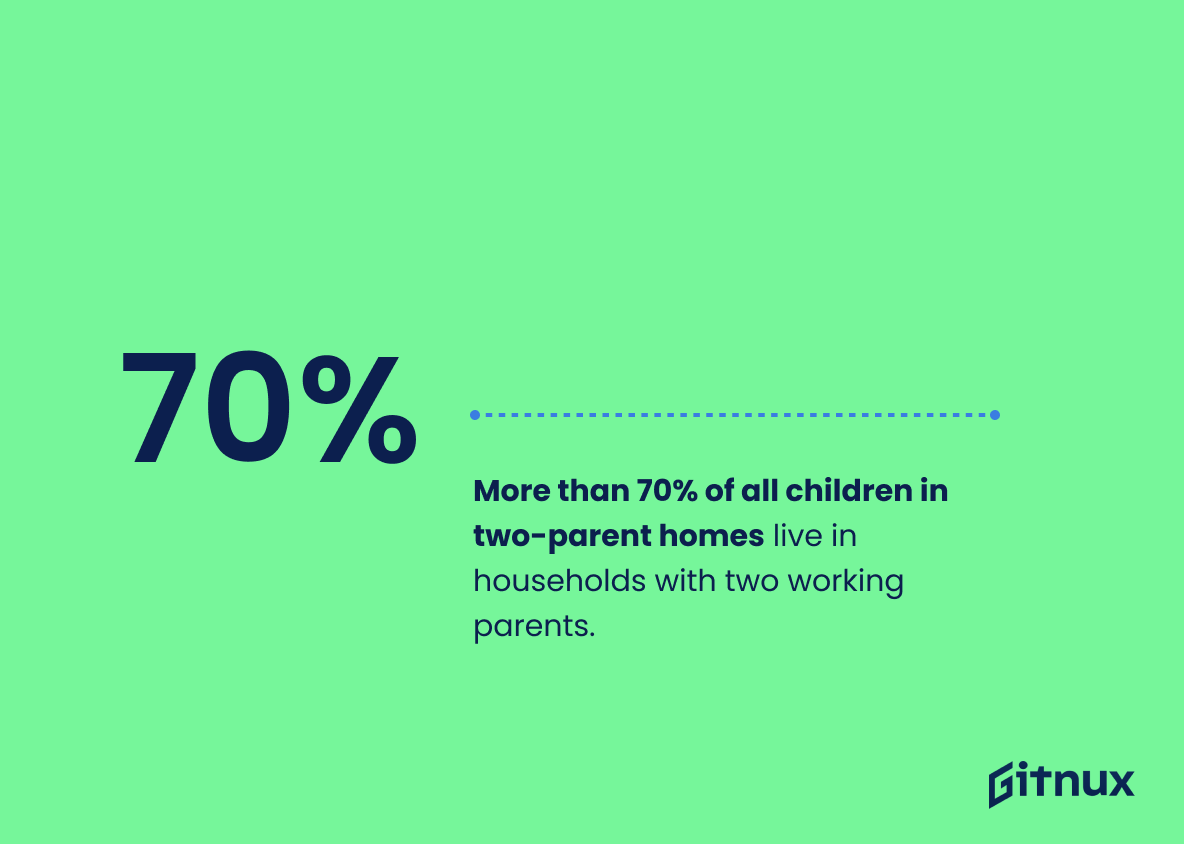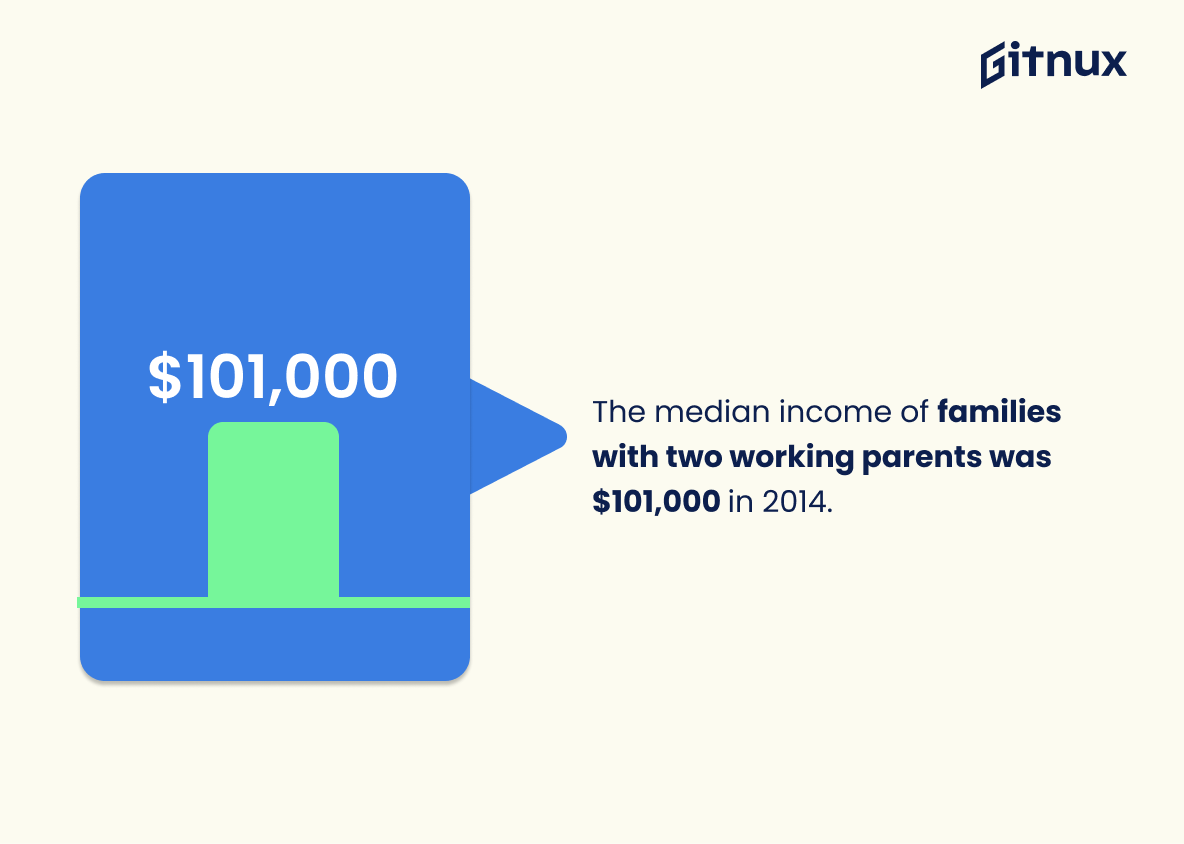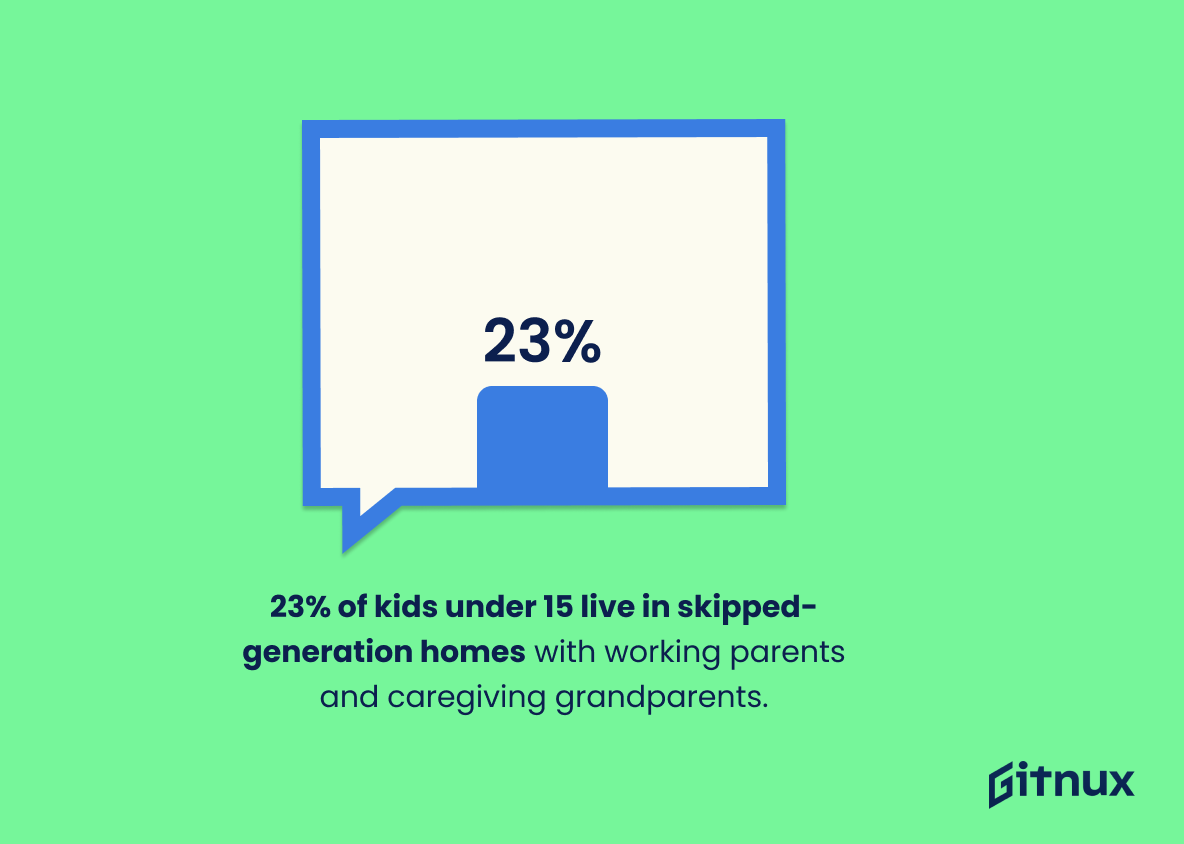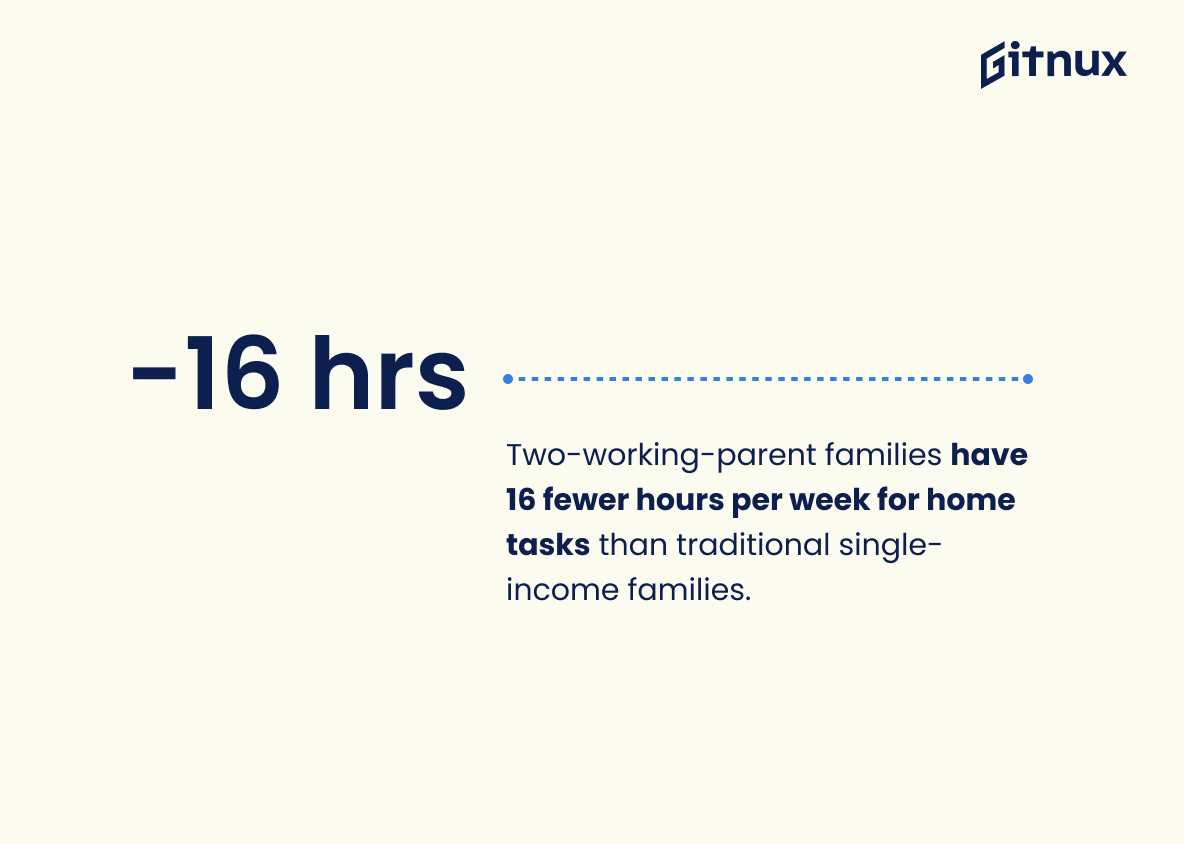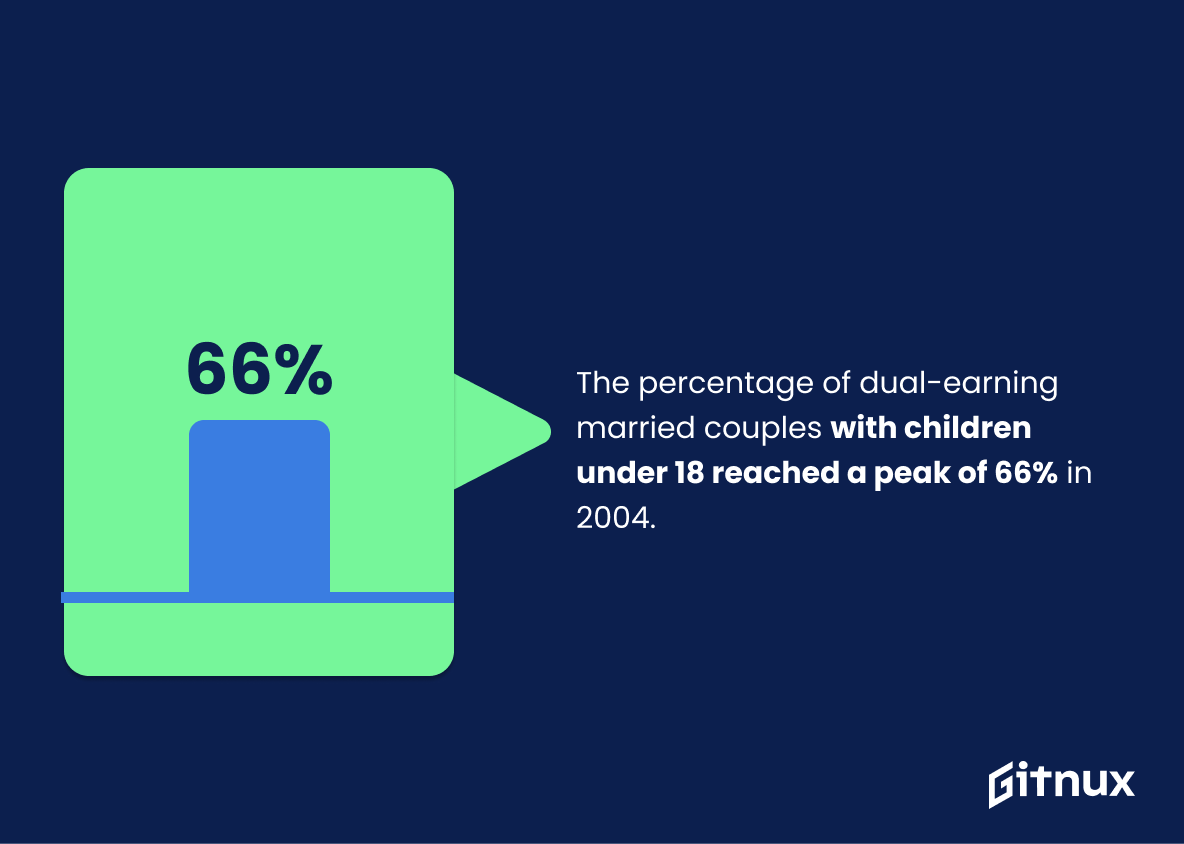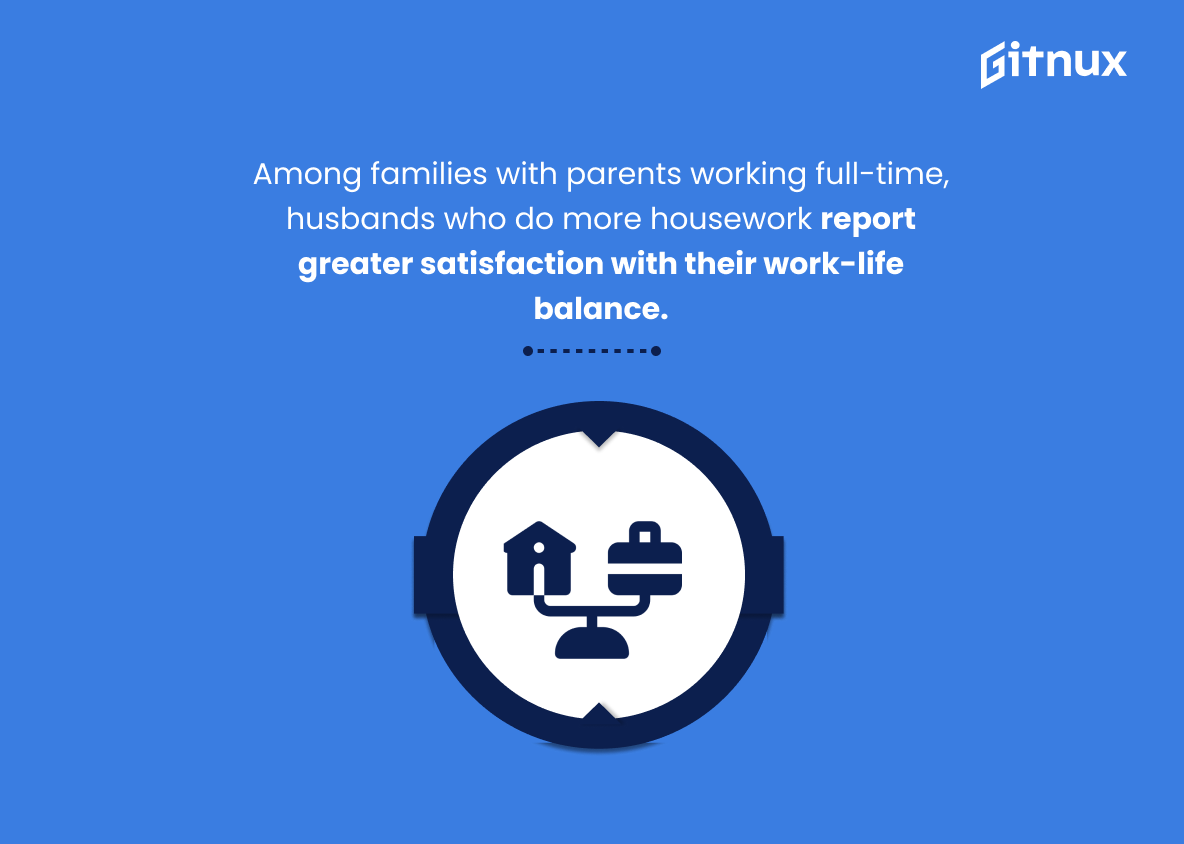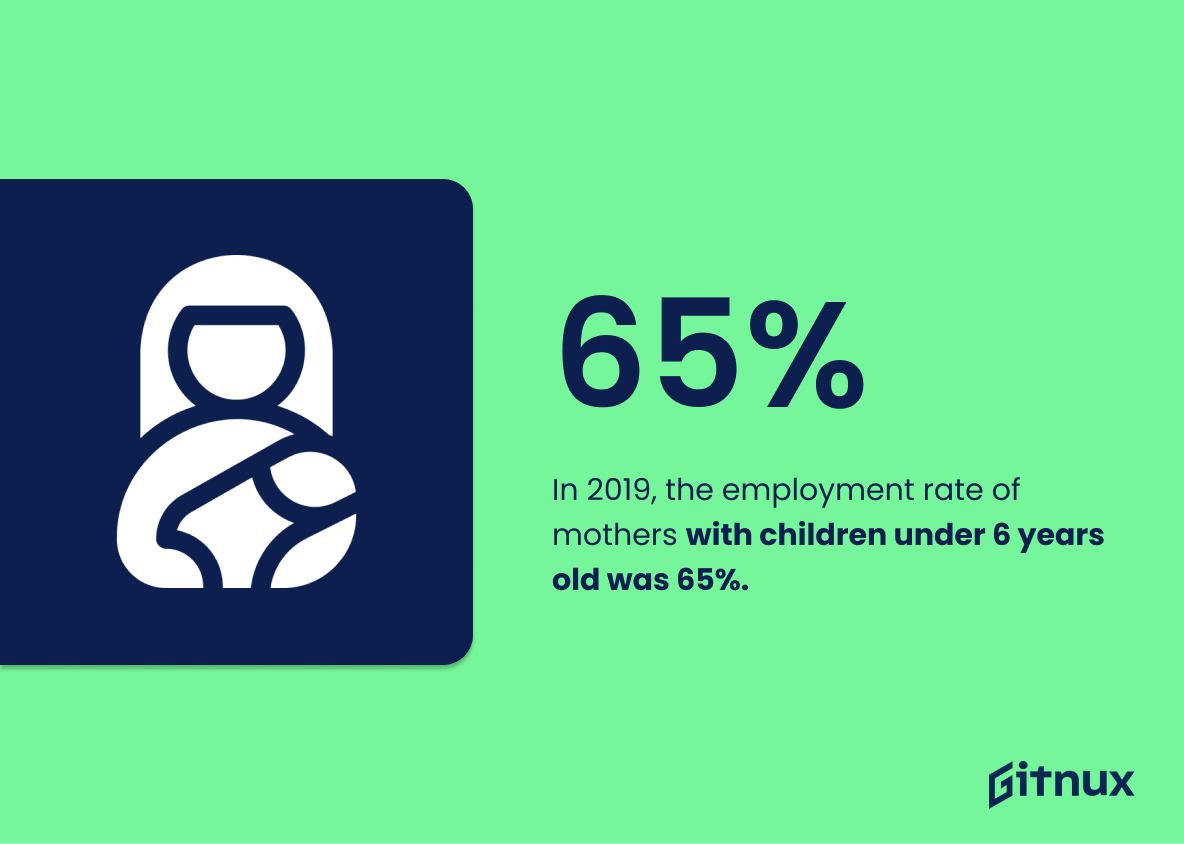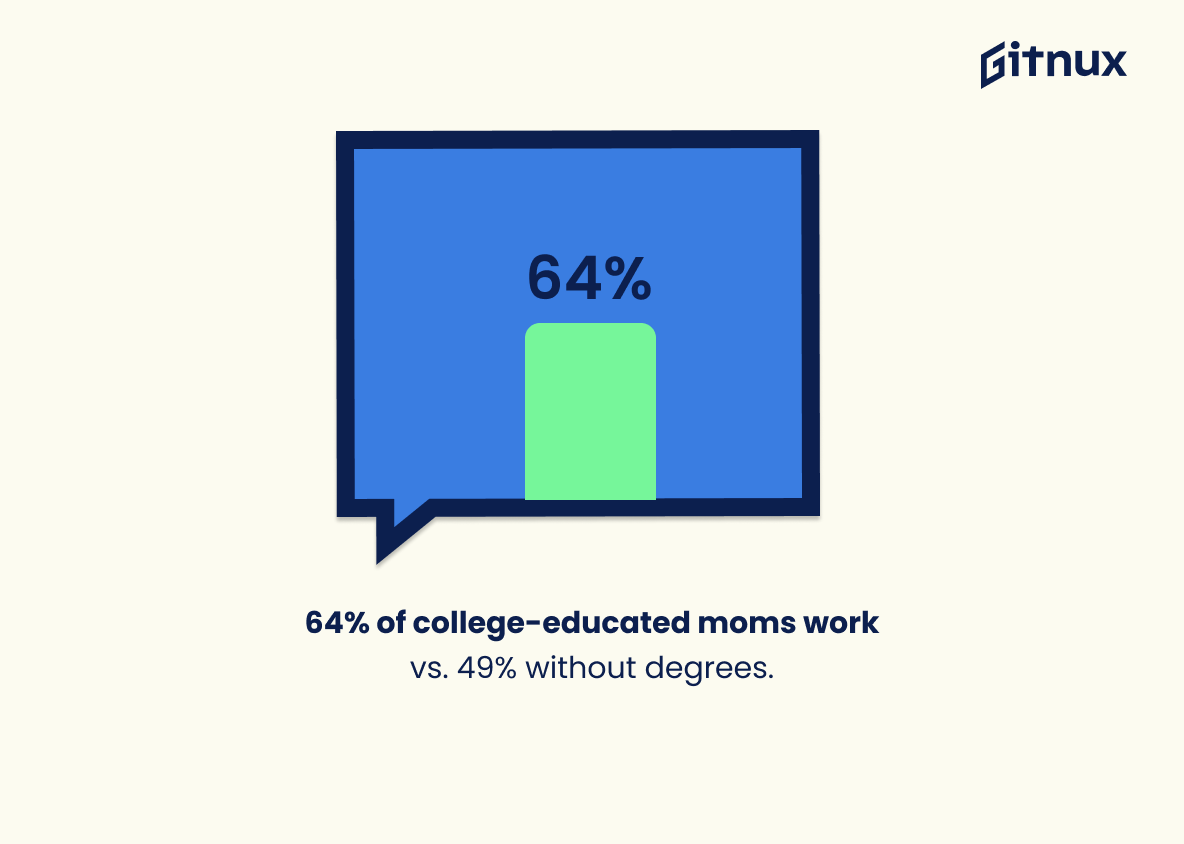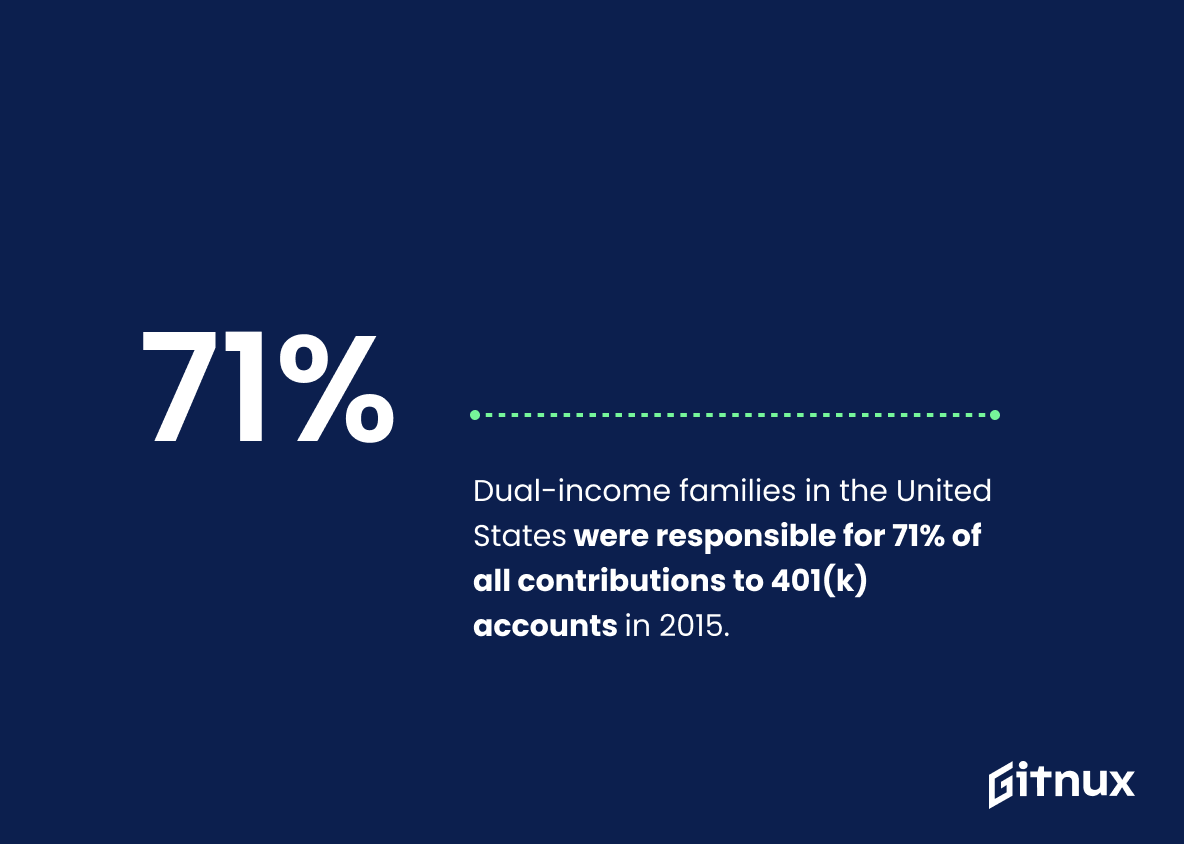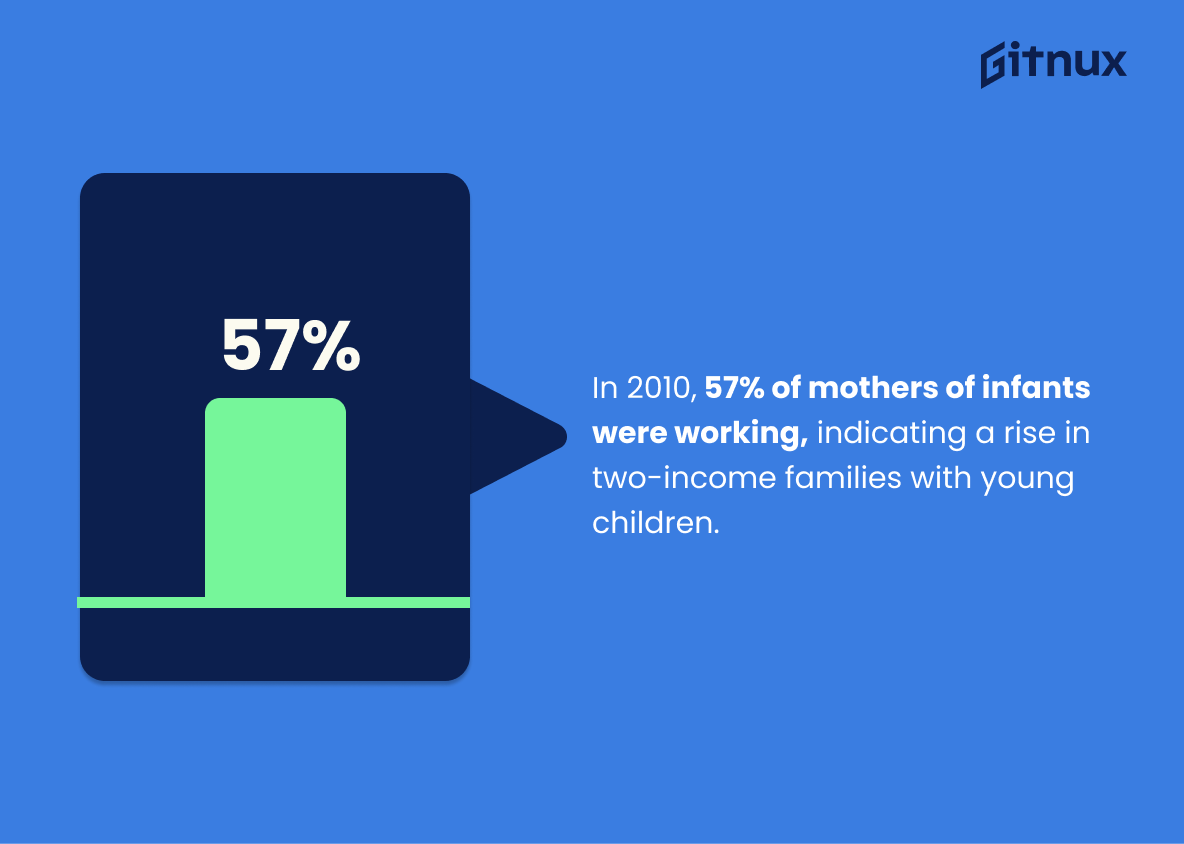In the U.S., 61% of married-couple families with children have both parents working, and these dual-earner couples spend 35% less time together than single-earner families. Among full-time employed parents, over 40% feel they don’t spend enough time with their kids. Since 1968, the number of families with at least one member staying home for childcare has dropped to 20%, while dual-income contributions to family income have risen from 37% to 44%, reaching 89% in households earning $75K or more.
This shift towards a dual-earner model presents challenges like fewer hours for home production, but also benefits like improved work-life balance satisfaction for husbands doing more housework. Personal savings rates have fallen from 15% to 5%, yet 71% of dual-earner families contributed to 401(k) accounts in 2015. Furthermore, 57% of mothers of infants now work, indicating more dual-income families with young children.
Interesting stats include 23% of households where grandparents provide childcare, 64% of college-educated women continuing work after motherhood, median incomes of $101K, and 62% of public school students coming from dual-parent homes. These figures illuminate the changing dynamics of modern parenting in America.
Two Income Families Statistics Overview
Nearly 20% of working parents indicate that at least one family member is staying at home to care for the children.
This statistic is a telling indication of the impact of two income families on the modern family dynamic. It shows that, despite the financial benefits of having two incomes, many families are still opting to have one parent stay at home to care for the children. This speaks to the importance of family and the value that many parents place on having a parent at home to provide care and support for their children.
Two-income families have doubled in percentage points since 1968, representing nearly 50% of all families in 2013.
This statistic is a powerful indicator of the changing dynamics of family life in the United States. It shows that the traditional single-income family is no longer the norm, and that two-income families are now the majority. This shift has had a profound impact on the way families live and work, and it is important to understand the implications of this change. By understanding the statistics surrounding two-income families, we can gain insight into the changing economic landscape and the challenges that come with it.
More than 70% of all children in two-parent homes live in households with two working parents.
This statistic is a powerful indicator of the prevalence of two-income families in today’s society. It shows that the majority of children in two-parent households are being raised in homes where both parents are working, which speaks to the importance of dual incomes in providing for a family. This statistic is especially relevant to a blog post about two-income families, as it provides a clear picture of the current state of the family dynamic.
The median income of families with two working parents was $101,000 in 2014.
This statistic is a telling indication of the financial success that two-income families can achieve. It demonstrates that when both parents are working, the family can bring in a substantial amount of income, which can be used to provide for their needs and wants. This statistic is an important reminder that two-income families can be a great source of financial stability and security.
62% of public school students come from two-income families.
This statistic is a telling indication of the prevalence of two-income families in the public school system. It speaks to the reality that many families rely on two incomes to make ends meet, and that this is a common experience for public school students. This statistic is important to consider when discussing the challenges and opportunities that two-income families face.
Personal savings rates for two-income families have decreased from 15% in 1975 to 5% in 2014.
This statistic is a telling indication of the financial pressures faced by two-income families in recent years. It demonstrates that, despite having two sources of income, families are struggling to save money and are instead relying on their incomes to cover their expenses. This is a worrying trend, as it suggests that two-income families are not able to build up a financial cushion to protect them in the event of an emergency or unexpected expense. It also highlights the need for two-income families to take a more proactive approach to budgeting and saving in order to ensure their financial security.
23% of children under 15 years old live in skipped-generation households, where both parents work and grandparents provide childcare.
This statistic is a telling indication of the reality that many two-income families face: the need for additional childcare support. With both parents working, grandparents often step in to provide the necessary care for their grandchildren. This statistic highlights the importance of grandparents in the lives of two-income families, and the need for them to be supported in their role.
Families with two working parents have 16 hours less per week of time available for home production compared to traditional one income earning families.
This statistic is a stark reminder of the reality that two income families face when it comes to managing their time. With 16 hours less per week of time available for home production, two income families are forced to make difficult decisions about how to allocate their limited resources. This can lead to increased stress and strain on the family, as well as a decrease in quality of life. Ultimately, this statistic serves as a reminder of the importance of finding a balance between work and home life for two income families.
The percentage of dual-earning married couples with children under 18 reached a peak of 66% in 2004.
This statistic is a telling indication of the changing dynamics of the modern family. In 2004, two-thirds of married couples with children under 18 were both earning an income, demonstrating the increasing prevalence of dual-earning households. This statistic is a powerful reminder of the importance of two-income families in today’s society.
Among families with parents working full-time, husbands who do more housework report greater satisfaction with their work-life balance.
This statistic is a powerful reminder that two-income families can benefit from a more equitable division of labor at home. When husbands take on more of the housework, it can lead to greater satisfaction with their work-life balance, which can be a major factor in the overall success of a two-income family.
In 2019, the employment rate of mothers with children under 6 years old was 65%.
This statistic is a telling indication of the prevalence of two-income families in today’s society. It shows that a significant portion of mothers with young children are employed, suggesting that many families rely on two incomes to make ends meet. This statistic is a powerful reminder of the importance of two-income families in our economy and culture.
64% of college-educated women continue to work after becoming a mother, compared to 49% of women without a college degree.
This statistic is a powerful indicator of the impact of education on a woman’s ability to remain in the workforce after becoming a mother. It demonstrates that college-educated women are more likely to stay in the workforce, providing a much-needed boost to two-income families. This is especially important in today’s economy, where the cost of living is rising and wages are not keeping up. The statistic highlights the importance of education in helping women to remain in the workforce and provide financial stability for their families.
Dual-income families in the United States were responsible for 71% of all contributions to 401(k) accounts in 2015.
This statistic is a testament to the financial power of dual-income families in the United States. It shows that, despite the challenges of managing two careers, these families are still able to make significant contributions to their 401(k) accounts. This highlights the importance of dual-income households in the economy and the potential for financial security they can provide.
In 2010, 57% of mothers of infants were working, indicating a rise in two-income families with young children.
This statistic is indicative of a larger trend in society: the rise of two-income families with young children. This shift in family dynamics has implications for the economy, the workplace, and the family unit itself. It speaks to the changing nature of the workforce, the need for more flexible work arrangements, and the challenges of balancing work and family life. It also speaks to the changing roles of mothers and fathers in the home, and the need for more support for families with young children. This statistic is an important part of the conversation about two-income families and the changing dynamics of family life.
The number of dual-income families in the United States increased from 20.6 million in 1970 to approximately 41.0 million in 2019.
This statistic is a powerful indicator of the changing landscape of family life in the United States. It shows that the number of dual-income families has more than doubled in the past 50 years, demonstrating the increasing reliance on two incomes to make ends meet. This shift has had a profound impact on the way families live and work, and it is an important statistic to consider when discussing the challenges and opportunities facing two-income families today.
Conclusion
This post reveals the dominance of two-income families in the U.S. Over 61% of married couples with children have both parents working, leading to 35% less shared time than single-earner families. About 43% of full-time working mothers and 46% of fathers feel they lack sufficient time with their kids. Today, nearly 20% of families have at least one member at home for childcare, while 50% are dual-income households, a significant increase from 25% in 1968.
Women now contribute 44% to family income, and 64% of college-educated mothers remain in the workforce post childbirth. The number of dual-income families has doubled since 1970 to 41 million, despite dwindling personal savings rates (15%-5% from 1975-2014) and rising childcare costs. Notably, 23% of children under 15 years old in two-parent homes receive childcare from grandparents. Despite certain challenges, dual-income families have grown due to the financial stability they offer, which can ultimately lead to an overall better quality of life.
References
0. – https://www.carsey.unh.edu
1. – https://www.ifstudies.org
2. – https://www.usatoday.com
3. – https://www.nytimes.com
4. – https://www.brookings.edu
5. – https://www.link.springer.com
6. – https://www.pewresearch.org
7. – https://www.ssa.gov
8. – https://www.marketwatch.com
9. – https://www.pewsocialtrends.org
10. – https://www.bls.gov
11. – https://www.nces.ed.gov
12. – https://www.childandfamilyblog.com
